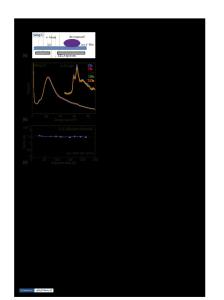A transmission electron microscope study of hardness indentations in MoSi 2
- PDF / 575,131 Bytes
- 8 Pages / 612 x 792 pts (letter) Page_size
- 96 Downloads / 367 Views
Transmission electron microscopy and electron diffraction were used to study hardness indentations made at room temperature in 〈001〉-oriented single crystals of MoSi2. Two families of slip systems, {110}〈001〉 and {101}〈010〉, were identified. The first system formed 〈001〉 dislocation loops by prismatic punching beneath the indenter, while the second system led to large rotations of the crystal lattice beneath the indenter. The lattice rotations were used to estimate the density of dislocations stored in this volume. The results demonstrate that the hardness response of MoSi2 can be explained by the expanding cavity model with most of the plastic accommodation occurring immediately beneath the indenter.
I. INTRODUCTION 1–3
A number of recent reviews have highlighted the potential application of MoSi2 as a structural material for use at high temperatures. Polycrystalline MoSi2 is ductile at temperatures above approximately 1100 °C, and in single-crystal form shows some ductility down to −100 °C.4 MoSi2 has a body-centered-tetragonal crystal structure (C11 b ) with lattice parameters of a ⳱ 0.3202 nm and c ⳱ 0.7851 nm. The mechanical properties of single crystals of MoSi2 have been studied over a broad temperature range.4–9 Although the details of the slip systems identified in these studies show some discrepancies, from a geometric point of view there should be sufficient slip systems to give polycrystalline ductility at high temperatures. The lack of ductility found in practice is usually attributed to the embrittling effects of intergranular films or the high critical resolved shear stress needed for activating certain slip systems. In this study we have used room temperature indentation testing as a means of studying the plastic flow behavior of single crystals of MoSi2. The compressive stress field found beneath the hardness indenter, coupled with the use of small indentation loads to avoid complications from fracture, permits the study of the deformation of small volumes of the crystal.10 For the purposes of this study, it is convenient to characterize the way in which researchers have modeled the response of materials in a hardness test into two broad
a)
Present address: Semiconductor Insights, Kanata, Ontario, Canada. b) Address all correspondence to this author. e-mail: [email protected] J. Mater. Res., Vol. 15, No. 4, Apr 2000
http://journals.cambridge.org
Downloaded: 03 Apr 2015
categories. (The specialist might quibble at this categorization, which ignores the important role of the geometry and hardness of the indenter; the size of the indent relative to key microstructural features, e.g., the grain size; and the indentation size effect; but here we are primarily interested in the underlying dislocation mechanisms and slip geometry.) In the first category, the socalled expanding cavity model, the hardness response is modeled as a plastic zone that expands radially beneath the indenter against the constraint provided by the surrounding elastic medium.11,12 The simplest dislocation analogue for this
Data Loading...











